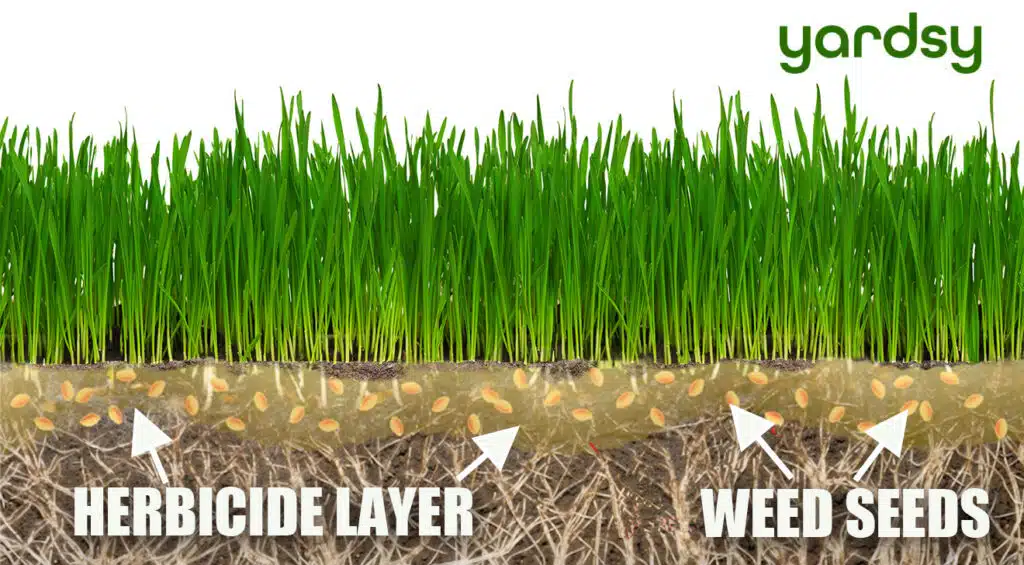Applying pre-emergents is crucial for homeowners who maintain a lush, weed-free lawn. This guide will take you through the ins and outs of pre-emergent herbicides – understanding what they are, figuring out the best time to use them, and learning how to apply them effectively. It’s all about keeping your green space looking its best throughout the year.
What are Pre-Emergents?
Pre-emergent herbicides are the unsung heroes in the world of lawn care. Unlike their post-emergent counterparts, which tackle weeds after they’ve sprouted, pre-emergents work underground, stopping weeds before they even start. They target weed seeds, preventing them from germinating and invading your lawn.
How Do Pre-Emergents Work?
Pre-emergents act as a barrier at the soil level, targeting the germination process of weed seeds. They’re effective against various weeds, ensuring your lawn stays unblemished. However, remember, they won’t help with existing weeds – that’s a job for post-emergent herbicides.

The Best Time to Apply Pre-Emergents
Understanding the importance of timing is crucial for effective weed control when applying pre-emergents. These herbicides are not just part of your lawn care routine; they form the foundation of your entire year’s weed control strategy. Pre-emergents work by creating an invisible barrier that stops weed seeds from growing. This barrier prevents the roots from establishing, meaning the weeds never surface, keeping your lawn pristine.
However, it’s important to note that while this method is among the most effective for weed control, it can be costly. But for many homeowners, this cost is a worthwhile investment in maintaining a healthy lawn year-round. The key to success with applying pre-emergents lies in early application. It’s crucial to apply them before the weeds start to grow. Missing this critical window means you’ll have more weed control work later in the year.
Guide To Applying Pre-Emergents By Season
- Early Spring: Ideal for most broadleaf weeds. Apply pre-emergent herbicides before these weeds start to grow. This is the general treatment period for preventing a variety of weed seeds from sprouting.
- Late Spring to Early Summer: Best for grassy weeds like crabgrass. These weeds germinate later in the season, so applying pre-emergents during this period is more effective.
- Fall: Use pre-emergents to target winter weeds. While fall applications can prevent winter weeds from germinating in spring, they are generally less effective than spring applications.
By adhering to this schedule and understanding the importance of early application, you can lay the foundation for a robust, weed-free lawn. Proper timing is not just a recommendation but necessary for effective weed prevention. This approach ensures that your lawn remains lush and free of weeds throughout the year, making it a worthwhile investment for any homeowner serious about lawn care.
Duration and Effectiveness
The effectiveness of applying pre-emergents typically spans 3-5 months. Factors like the type of herbicide, soil conditions, and weather can influence their longevity. It’s a balancing act – applying too little won’t be effective, and too much could harm your lawn.
Do It Yourself Tips To Apply Pre-Emergent Herbicides

Applying pre-emergent herbicides correctly is as crucial as choosing the right time for application. Here’s a comprehensive guide to help DIY homeowners apply pre-emergent herbicides effectively:
Preparation
- Choose the right herbicide (granular or liquid, selective or non-selective).
- Have the right tools: a granular spreader or a liquid herbicide sprayer.
Weather Check
- Apply when the forecast is clear to avoid rain washing the herbicide away.
- Ensure the ground is dry, especially after recent rains.
Granular Herbicides
- Use a manual or hand-held spreader.
- Fill with herbicide as per label instructions and calibrate for your yard.
- Spread evenly, overlapping passes without exceeding the recommended rate.
Liquid Herbicides
- Mix herbicide with water as directed.
- Use a sprayer to apply systematically, ensuring even coverage.
Type of Herbicide
- Selective herbicides: apply over areas with specific weeds.
- Non-selective herbicides: apply carefully to targeted weed areas only.
Watering Post-Application
- Water your lawn within 3-5 days to activate the herbicide.
- Granular types may need more water for effective soil penetration.
Common Mistakes to Avoid
- Ensure even application to prevent weed patches.
- Avoid applying too little or too much herbicide.
- Don’t combine with other lawn care activities like aeration or overseeding.
- Wait a year before laying new sod on treated areas.
Safety and Environmental Considerations
Safety first! Following the product’s safety guidelines when applying pre-emergents, especially in homes with pets and children. Opt for eco-friendly options to minimize environmental impact. Always wear protective gear and store herbicides out of reach of children and pets.
Professional Pre-Emergent Application for a Lush Lawn
With the many variables that can impact the proper application of pre-emergent herbicides, many homeowners prefer to have a professional lawn care service provide this service for them. Trained professionals can identify the appropriate treatment needed for your particular weed control issues and take care of applying the right herbicides at the right time. Why DIY and deal with purchasing and applying these chemical treatments when an expert provider can easily take care of this for you?
Applying pre-emergents is essential for homeowners who cherish a healthy, weed-free lawn. With the right approach and timing, you can prevent weeds from ever becoming a problem in your yard. If you need professional help or advice, don’t hesitate to contact the weed control experts at Yardsy. Our team is always ready to assist you in achieving the perfect lawn!



















































